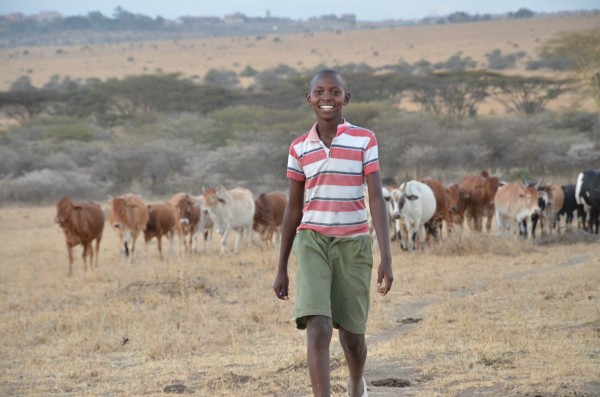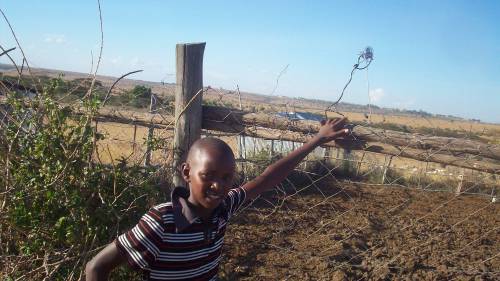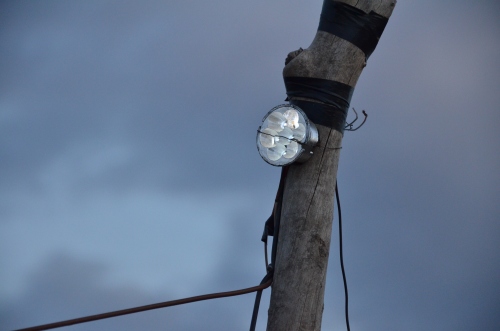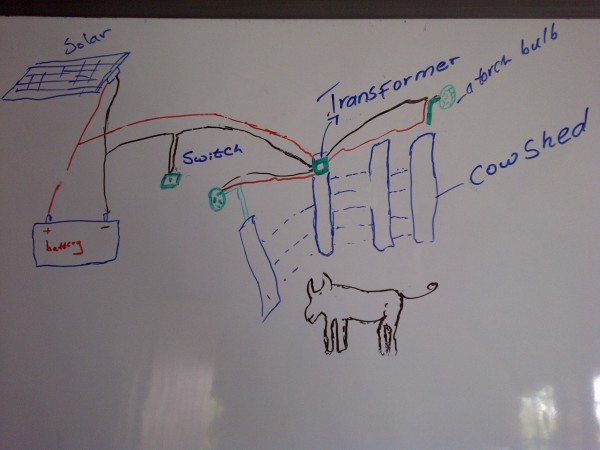Richard Turere lives in Empakasi,on the edge of the Nairobi National Park, just south of the City of Nairobi. He is responsible for herding his family the livestock and keeping them safe from predators, especially lions. Being so close the park puts this family’s cattle right in the path of lions and every month they lost cows, sheep and goats. Nairobi Park has the worlds highest density of lions, and they often predate on livestock which are easier to catch.

At the age of 11 Richard decided to do something about his family’s losses. He observed that the lions never struck the homesteads when someone was awake and walking around with a flashlight. Lions are naturally afraid of people. He concluded that lions equate torches with people so he took the led bulbs from broken flashlights and rigged up an automated lighting system of four or five torch bulbs around the cattle stockade. The bulbs are wired to a box with switches, and to an old car battery charged with a solar panel that operates the family Television set. The lights don’t point towards the cattle, or on any property, but outwards into the darkness. They flash in sequence giving the impression that someone is walking around the stockade.

In the two years that his lion light system has been operating, the Turere family has had no predation at night by lions. To Richard he was just doing his job – protecting the herds. His father is beaming, stock thieves will also think twice about visiting a homestead where it appears as if someone is awake. Five of the neighbours noticed that they were getting hit by lions but not the Turere homestead. Richard has already installed the lion lights system in their bomas too.
For conservation and human wildlife Conflict management, this simple innovation is a breakthrough. The Kenya Wildlife Service report that human wildlife Conflict has cost the government Ksh71 million in compensation in 2011 alone. In Kitengela consolation of several million has been paid to the community for the loss of livestock to lions alone. This figure will rise dramatically as new legislation comes into play. Richards little device of four or five lamps, some wires and a few batteries costs less than ten dollars and has saved his father tens of cattle and therefore it has saved donors several thousand dollars in consolation. The alternative being applied elsewhere is the construction of lion proof fences but at the cost of 1,000 dollars just for materials, then there’s the cost of transport and labour it is way out of the price range fore the average pastoralist. Richards invention is cheap, local, cost effective and easy and quick to install and to maintain.

What is extraordinary about this story is that Richard has had no books or access to technical information. He says he does not know where he gets the ideas or the knowledge, and yes, he has given him self plenty of electric shocks. His father James is proud of his son, and has given him space to tinker and collect bits of gadgetry. Like so many boys, Richards dream has something to do with aircraft – he wants to be an engineer. When I first asked him about lions he said he hates them, but his invention has saved many as lions are often killed in retaliation for killing livestock. Now we need help on scaling up this idea.

Richard has just been awarded a scholarship at Brookhouse School where he intends to excel. This was all possible through support from Friends of Nairobi Park (FoNNaP) members, Michael Mbithi, Nickson Parmisa, Neovitis and Elvis, Winnie Khasakhala, Brookhouse School, AAR who have provided full medical cover.


Wow. The invention is very inspiring. Very simple invention that has save his sleepless nights which he can now utilise studying and beefing up his knowledge. Kudos to BrookHouse School and any other institution that has helped the boy to get scholarship
Quite an achievement for a 13 year old!
When I was his age I was a tinkerer too, but saving his family a few thousands Dollars? Brilliant!
o/
J.
Very inspiring.
I would like to ‘electronically follow’ this young man as he travels through life. Keep up the great work Richard!
This kid has a great future as an engineer and inventor. I hope he can get some sponsorship to further deploy this system to other families. Perhaps some sort of fundraising on the web like a Kickstarter and a little adult support to help him with business.
Given the right opportunity, this kid can go a long way. Kinda reminds me of the story of William Kamkwamb of Malawi (book is called the boy who harnessed the wind)
The measure of genius is to be able to adapt what is available to meet a specific purpose and achieve practical results.
What a smart boy – congratulations – it’s wonderful to hear something positive from east Africa regarding lions.
I guess I should have called Richard a smart young man since he’s now 13. . .
This is ingenious. Kudos to the young man.
Am impressed beyond words. This is a true moran
Very inspiring story. Richard is a smart young man who deserves all the good breaks in this world. I wish him more blessings and success.
Please find the Spanish translation of this great piece 🙂
http://espafrigadget.wordpress.com/2012/04/18/chico-keniano-de-13-anos-inventa-un-sistema-de-alumbrado-contra-leones/
Keep up the good work!
I wonder how long it will take the Kenyan government to realise that, if they give the herders the money to put this into practice on their lands, it will save them a great deal of money ! They should also give Richard a fee for thinking of it !
The power of people. It’s amazing what happens when we use what we have. Great thinking Richard. Well done.
Very inspiring. Even more so, that the story does not end at awe as happens quite often. Cheers to the sponsors and Afrigadget for telling the story. I hope to hear more about Richard in the future…
This post was very inspiring! Someone with no education about circuits who can put a brilliant idea into action is truly special. This is just another example of how great ideas don’t have to be revolutionary inventions and can come from children. Given the right opportunity, Richard could really become something special who can leave an impact on the world. His mind connected the dots in an unique way and was able to find a simple and cheap solution to a problem that cost his family many problems.
What an innovative young man. The fact that a man of such a young age could come up with such a complex idea at a young age speaks volumes for his potential and for his future. Placing his cost effective method side by side with the government’s alternative only further adds to the boy’s potential. Unknowingly, he could have laid the groundwork for a method of saving cattle that could save an exceptional amount of money. The sky truly is the limit for this young man.
That man has a lot of potential when it comes to innovation.
This is amazing! This young man’s invention is a testament to the fact that innovation can come from anywhere. It is astonishing that the common solution of lion-proof fences cost 1000s of dollars. On the other hand, Richard’s solution is cheap, effective, and easy to maintain. Hopefully he excels in school and who knows what else he’ll be able to contribute. Richard is a great role model for people everywhere. If you are presented with a problem, don’t just accept it or do what everyone else is doing. Be creative!
Great simple things bring great change if heard. Muhammad Naeem UL Fateh, PhD
This is great. I also have a friend in Nigeria who has just made a soil temperature data logger. It was a great invention.
I’m so happy for you Richard! You did a real good job!
I wish you lots of succes in your future life!
Great job! Now, how do we get this information — and the tools needed to do the job — to those who need them?
A breath taking article. So what next post?
Wonderful !
How do I get in touch with Richard? we are starting a program (Youth Venture) where we are looking out for (identifying), inspiring and supporting young changemakers 12-22 year olds(Ashoka East Africa: eastafrica.ashoka.org) and Richard is one young man who is and will be an inspiration to many other young people.
Anyone with further information on how I could reach him? If anyone here also knows any such young people please send me an email: pwakesho@ashoka.org
Richard,
I lived in Kenya for 5 years, and I met so many kids who were natural young engineers! Work hard in school so that you can keep on putting your ideas into practice! You are a talented young man, and your nation needs your creativity, insight and practicality! Keep up the good work!
Blessings,
Mary
Cincinnati, OHio USA
Hi Richard,
This is a wonderful idea and can really save cats most many parts of Africa especially in western uganda where people still domesticate animals within a protected area like Queen Elizabeth National Park where cats at night toe them causing unneccessary poisoning/killing in literiation for the cows lost.
I call bullshit.
1) transformers work with AC not DC
2) there is no way to automatically sequence the lights with the parts listed or shown in the diagram.
Good idea but it won’t be affective for very long. The lions will get used to it and then go after the cattle again.
Also the transformer in the crude schematic is confusing.